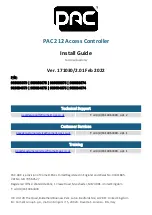
Page
20 of 40
Number
PM820010
HVAC: SmartAir eHVAC System
e. If all signals are correct and the safety controls
thermal limit on compressor, high pressure
switch and temp sensor /freeze switch are okay,
the control is calling for cold and the sleeper tem-
perature is above 60 degrees, you should have
voltage out on the three wires connected to the
compressor terminals: A – Blue, B – Orange and
C – Yellow. (ABC – BOY), and the compressor
should run.
f. If the compressor does not operate, disconnect
the three wires from the compressor. You will
have to remove plastic cap from the top of com-
pressor.
• Using a volt meter check each wire, positive
on (blue, orange or yellow) negative to bat-
tery ground. If you do not have a 6 volt pulse
voltage out on each wire, replace the control-
ler. Pulse voltage means the controller will
cycle to each colored wire. You should see
the voltage appear and disappear continu-
ously.
• If you do have a 6 volt pulse voltage out and
the compressor does not run you have a
defective compressor. Contact the Peterbilt
Service line.
I. Condenser Fan Motor Testing
First do a visual inspection of all fan parts.
NOTE
This fan cycles on and off with the compressor! Before
testing fan, start the unit, make sure the control is set
for full cold and the temperature in the truck will allow
the control to attempt to start the compressor and fan.
Turn the unit on, you should have 12 volts across termi-
nals 1 and 2 at the condenser fan connector. If you do not
have 12 volt at the fan, check fuse F2 And relay R1. If
condenser fan 12 volt power is okay, check condenser
speed signal from C7 on main controller. This voltage will
vary depending on requested speed: approximately 1.6
for low, 2.6 for high. If all voltages are correct, and the fan
does not run, it is defective, and needs to be replaced.
Using a DC ammeter you can check the amperage draw
of the blower. Normal amps approximately 5–10 depend-
ing on speed requests.
CAUTION
If attempting to connect blower to an outside power
source, internal electronic components are sensitive to
arcing or reverse polarity! Damage will occur.
J. Evaporator Blower Motor and Linear
Power Module Testing
First do a visual inspection of all blower parts. The evapo-
rator blower speed is controlled by the LPM. See “
Turn the unit on, you should have 12 volt at the LPM pins
6 (pos) and pin 5 (neg), if you do not, check fuse F3 and
relay R2. If you have 12 VOLT main power, check for the
speed signal voltage on the LPM at pin 3 coming from the
system controller pin C13. You should have approxi-
mately 5.6V for speed 1, 4.9V for speed 2 and 3.1V for
speed 3. If all of these voltages are correct, check the
output voltage from the LPM pins 1 and 2 going to the
blower. You should have approximately 6.6V out for
speed 1, 8.1V out for speed 2 and 10V out for speed 3 to
the blower.
If fan does not run, it is defective, and needs to be
replaced.
Using a DC ammeter you can check the amperage draw
of the blower. Normal amps will range from 4 to 10 amps.
CAUTION
If attempting to connect blower to an outside power
source, internal electronic components are sensitive to
arcing or reverse polarity! Damage will occur!
K. Compressor Rubber Mounts
Visual inspection of the compressor rubber mounts may
be necessary if excessive vibration is present. Check for
loose mounting nuts. If mounting nuts and captive studs
are okay, vibration could be from the internal part of the
compressor.
















































